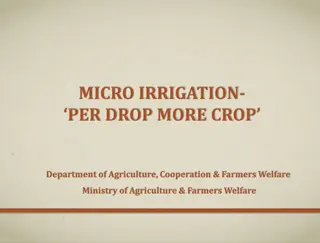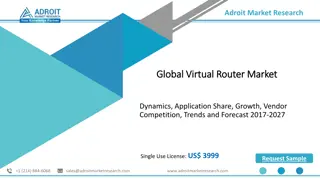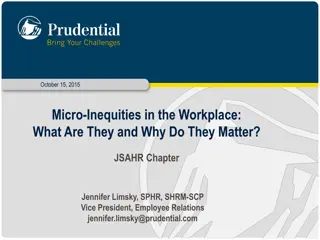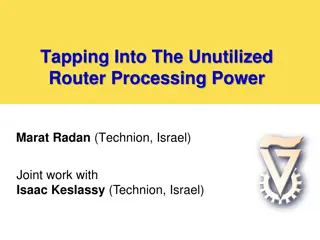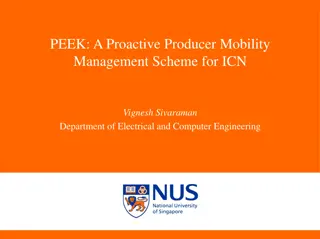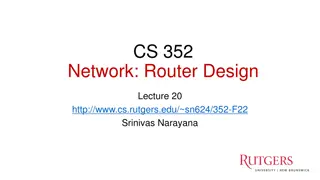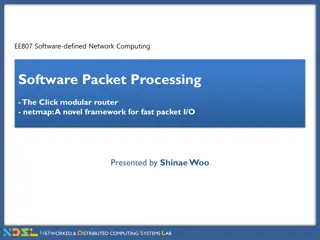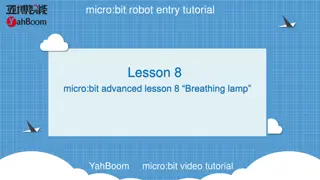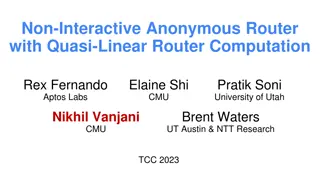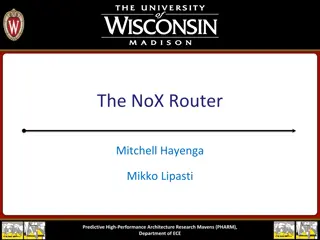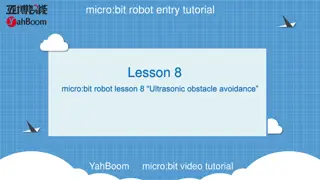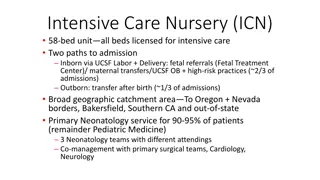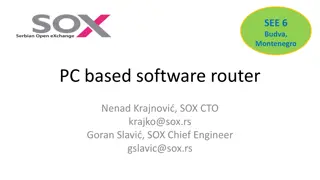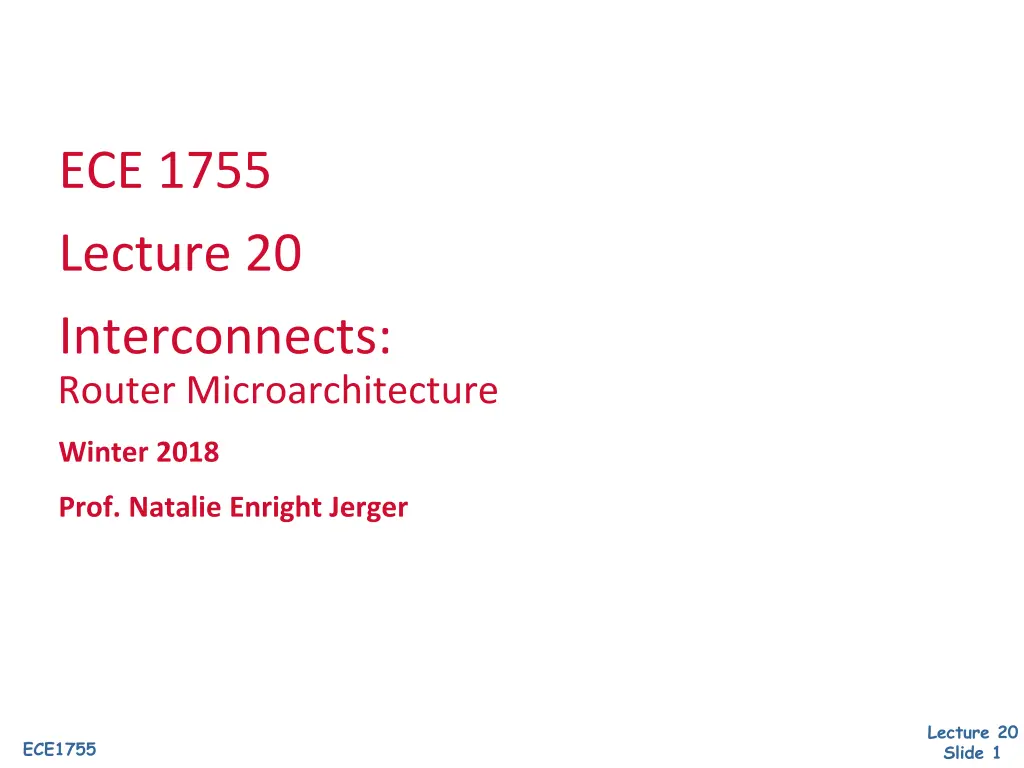
Router Microarchitecture Overview: Interconnects & Virtual Channels
Explore the intricacies of router microarchitecture in the context of interconnects and virtual channels. Learn about topology, routing paths, flow control, and the implementation of routing mechanisms impacting delay and energy efficiency. Delve into the components of a virtual channel router, including credits, VC allocators, switch allocators, and input buffers. Understand the baseline router pipeline stages and performance considerations for efficient data routing in communication networks.
Download Presentation

Please find below an Image/Link to download the presentation.
The content on the website is provided AS IS for your information and personal use only. It may not be sold, licensed, or shared on other websites without obtaining consent from the author. If you encounter any issues during the download, it is possible that the publisher has removed the file from their server.
You are allowed to download the files provided on this website for personal or commercial use, subject to the condition that they are used lawfully. All files are the property of their respective owners.
The content on the website is provided AS IS for your information and personal use only. It may not be sold, licensed, or shared on other websites without obtaining consent from the author.
E N D
Presentation Transcript
ECE 1755 Lecture 20 Interconnects: Router Microarchitecture Winter 2018 Prof. Natalie Enright Jerger Lecture 20 Slide 1 ECE1755
Overview Topology: connectivity Routing: paths Flow control: resource allocation Router Microarchitecture Implementation of routing, flow control and router pipeline Impacts per-hop delay and energy Lecture 20 Slide 2 ECE1755
Router Microarchitecture Overview Focus on microarchitecture of Virtual Channel router Router complexity increase with bandwidth demands Simple routers built when high throughput is not needed Wormhole flow control, unpipelined, limited buffer Lecture 20 Slide 3 ECE1755
Virtual Channel Router Credits In Credits Out VC Allocator Route Computation Switch Allocator VC 1 VC 2 Input 1 Output 1 VC 3 VC 4 Input buffers VC 1 VC 2 Input 5 Output 5 VC 3 VC 4 Input buffers Lecture 20 Slide 4 Crossbar switch ECE1755
Router Components Input buffers, route computation logic, virtual channel allocator, switch allocator, crossbar switch Most OCN routers are input buffered Use single-ported memories Buffer store flits for duration in router Lecture 20 Slide 5 ECE1755
Baseline Router Pipeline BW RC VA SA ST LT Logical stages Fit into physical stages depending on frequency Canonical 5-stage pipeline BW: Buffer Write RC: Routing computation VA: Virtual Channel Allocation SA: Switch Allocation ST: Switch Traversal LT: Link Traversal Lecture 20 Slide 6 ECE1755
Baseline Router Pipeline (2) 1 2 3 4 5 6 7 8 9 Cycle BW RC VA SA ST LT Head BW SA ST LT Body 1 BW SA ST LT Body 2 BW SA ST LT Tail Routing computation performed once per packet Virtual channel allocated once per packet Body and tail flits inherit this info from head flit Lecture 20 Slide 7 ECE1755
Router Pipeline Performance Baseline (no load) delay = 5cycles+ linkdelay ( ) hops+ tserialization Ideally, only pay link delay Techniques to reduce pipeline stages Lecture 20 Slide 9 ECE1755
Pipeline Optimizations: Lookahead Routing At current router perform routing computation for next router Overlap with Buffer Write (BW) BW RC VA SA ST LT Precomputing route allows flits to compete for VCs immediately after BW Lecture 20 Slide 10 ECE1755
Pipeline Optimizations: Speculation Assume that Virtual Channel Allocation stage will be successful Valid under low to moderate loads Entire VA and SA in parallel BW RC VA SA ST LT If VA unsuccessful (no virtual channel returned) Must repeat VA/SA in next cycle Prioritize non-speculative requests Lecture 20 Slide 11 ECE1755
Pipeline Optimizations: Bypassing When no flits in input buffer Speculatively enter ST On port conflict, speculation aborted VA RC ST LT Setup In the first stage, a free VC is allocated, next routing is performed and the crossbar is setup Lecture 20 Slide 12 ECE1755
Pipeline Bypassing Lookahead Routing Computation Virtual Channel Allocation 1a Inject N 1 1b S A E W N S E Eject W 2 No buffered flits when A arrives Lecture 20 Slide 13 ECE1755
Speculation A succeeds in VA but fails in SA, retry SA Virtual Channel Allocation 2a 1a Lookahead Routing Computation 2b Switch Allocation 3 Port conflict detected Inject 1 1c 1b N B 1 1c 1b S A E W W N S E Eject 4 Lecture 20 Slide 14 3 ECE1755
Buffer Organization Physical channels Virtual channels Single buffer per input Multiple fixed length queues per physical channel Lecture 20 Slide 15 ECE1755
Buffer Organization VC 0 tail head VC 1 tail head Multiple variable length queues Multiple VCs share a large buffer Each VC must have minimum 1 flit buffer Prevent deadlock More complex circuitry Lecture 20 Slide 16 ECE1755
Buffer Organization Many shallow VCs? Few deep VCs? More VCs ease HOL blocking More complex VC allocator Light traffic Many shallow VCs underutilized Heavy traffic Few deep VCs less efficient, packets blocked due to lack of VCs Lecture 20 Slide 17 ECE1755
Switch Organization Heart of datapath Switches bits from input to output High frequency crossbar designs challenging Crossbar composed for many multiplexers Common in low-frequency router designs i40 i30 i20 i10 i00 sel0 sel1 sel2 sel3 sel4 o0 o1 o2 o3 o4 Lecture 20 Slide 18 ECE1755
Switch Organization: Crosspoint Inject w columns N w rows S E W W N S E Eject Area and power scale at O((pw)2) p: number of ports (function of topology) w: port width in bits (determines phit/flit size and impacts packet energy and delay) Lecture 20 Slide 19 ECE1755
Crossbar speedup 10:5 crossbar 5:10 crossbar 10:10 crossbar Increase internal switch bandwidth Simplifies allocation or gives better performance with a simple allocator More inputs to select from higher probability each output port will be matched (used) each cycle Output speedup requires output buffers Multiplex onto physical link Lecture 20 Slide 20 ECE1755
Arbiters and Allocators Lecture 20 Slide 21 ECE1755
Arbiters and Allocators Allocator matches N requests to M resources Arbiter matches N requests to 1 resource Resources are VCs (for virtual channel routers) and crossbar switch ports. Lecture 20 Slide 22 ECE1755
Arbiters and Allocators (2) Virtual-channel allocator (VA) Resolves contention for output virtual channels Grants them to input virtual channels Switch allocator (SA) that grants crossbar switch ports to input virtual channels Allocator/arbiter that delivers high matching probability translates to higher network throughput. Must also be fast and/or able to be pipelined Lecture 20 Slide 23 ECE1755
Separable Allocator Need for pipelineable allocators Allocator composed of arbiters Arbiter chooses one out of N requests to a single resource Separable switch allocator First stage: select single request at each input port Second stage: selects single request for each output port Lecture 20 Slide 29 ECE1755
Adaptive Routing & Allocator Design Deterministic routing Single output port Switch allocator bids for output port Adaptive routing Returns multiple candidate output ports Switch allocator can bid for all ports Granted port must match VC granted Return single output port Reroute if packet fails VC allocation Lecture 20 Slide 33 ECE1755
On-Chip Network Summary Lecture 20 Slide 35 ECE1755
Interconnection Network Summary Throughput given by flow control Latency Throughput given by routing Zero load latency (topology+routing+flo w control) Throughput given by topology Min latency given by routing algorithm Min latency given by topology Offered Traffic (bits/sec) Latency vs. Offered Traffic Lecture 20 Slide 36 ECE1755
Latency Throughput Gap 60 50 Throughput gap Latency (cycles) 40 30 20 Latency gap 10 0 0.1 0.3 0.5 0.7 0.9 Injected load (fraction of capacity) Ideal On-chip Network Aggressive speculation and bypassing 8 VCs/port Lecture 20 Slide 39 ECE1755
Key Research Challenges Low power on-chip networks Power consumed largely dependent on bandwidth it has to support Bandwidth requirement depends on several factors Beyond conventional interconnects Power efficient link designs 3D stacking Optics Resilient on-chip networks Manufacturing defects and variability Soft errors and wearout Lecture 20 Slide 43 ECE1755



